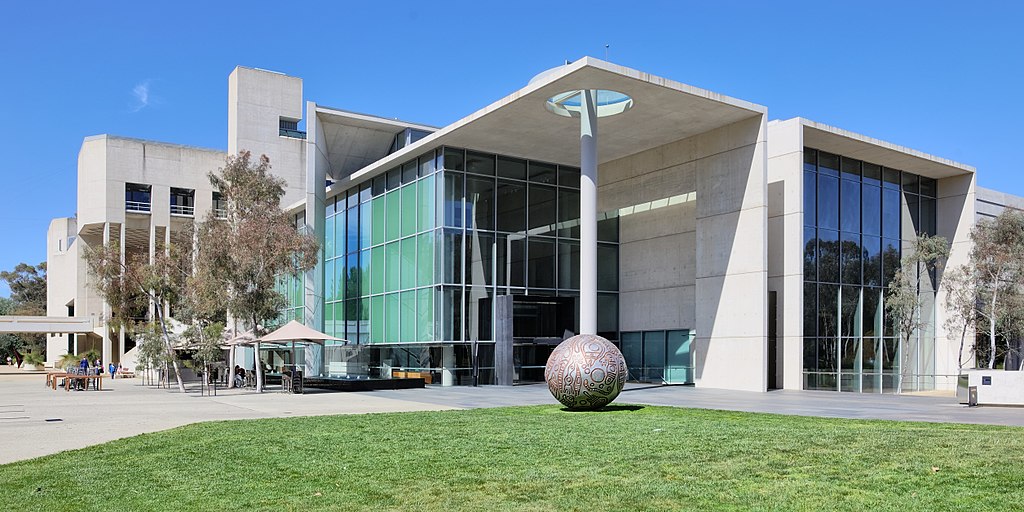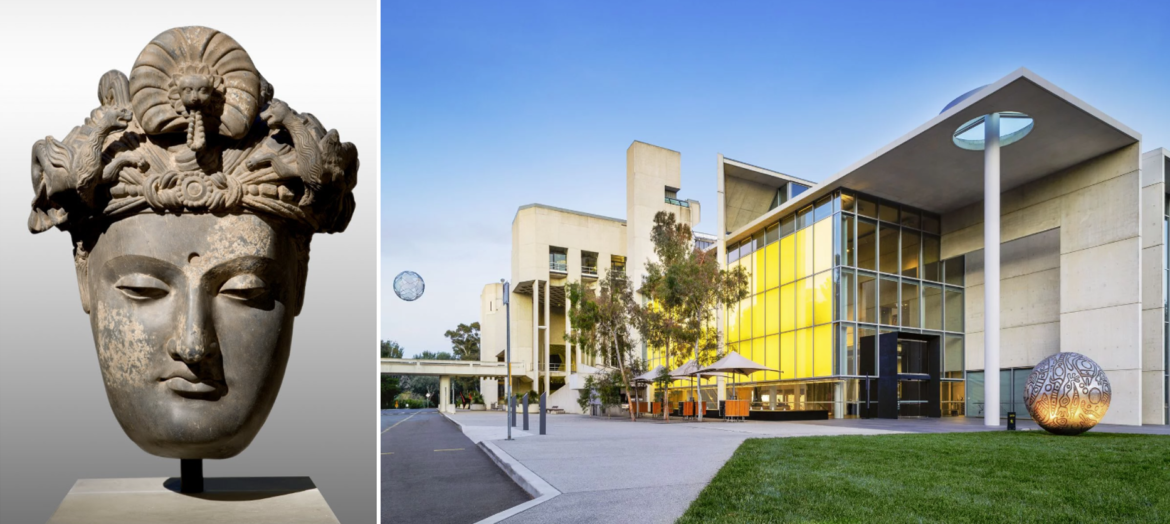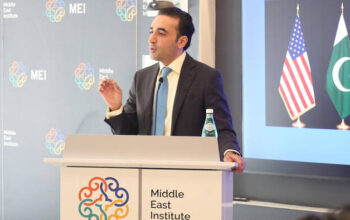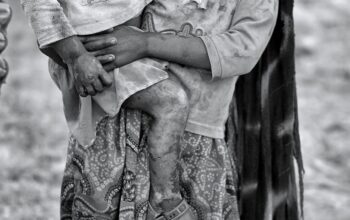A monumental head of a bodhisattva is returning to Pakistan from Australia after being smuggled out of the country by art thieves. A veteran curator of Gandhara Art says it could have originated in the Taxila Valley.
By Naveed Naqvi
ISLAMABAD: A monumental head of a bodhisattva returning to Pakistan from Australia could have originated in the Taxila Valley, a veteran curator of Gandhara Art has said.
A Gandharan head of a bodhisattva, dating back to around the 3rd Century CE, was handed over to Pakistan by the National Gallery of Australia earlier this month.

Details
Title: Head of a bodhisattva
Creator: Gandharan region, Afghanistan or Pakistan
Date Created: 3rd?4th century
Location: Gandharan region, Afghanistan or Pakistan
Physical Dimensions: w444 x h543 x d300 cm
Type: Sculpture,grey schist
Talking to Independent Pakistan, former curator of Archaeological Museum Taxila Abdul Nasir said that head of a bodhisattva is very unique and different.
“I have never seen such a head in my memory”, Nasir said in an interview. “It has the turban on Buddha’s head with dragons woven into it. Never seen such sculpture in Gandhara art till date, it is very different and unique. It seems very valuable”.
This magnificent historical work of art was illegally smuggled out of Pakistan by an international crime syndicate led by discredited Indian art collector Subhash Chandra Kapoor, who sold it to the National Gallery of Australia in 2006.
However, the Gallery deaccessioned it after finding its uncertain legal and ethical status and association with Art of the Past under its ongoing Provenance Research Project.
Consequently, the National Gallery of Australia in close coordination with the High Commission for Pakistan decided to return this historical work of art to the land and the people it belonged to. Last week, the relic was handed over the Pakistani High Commission in Canberra.
Speaking on the occasion, Pakistan’s High Commissioner to Australia Zahid Hafeez Chaudhri described the handing over ceremony as a landmark event as it underscored the importance of legal and ethical aspects of the historical works of art.
The High Commissioner particularly acknowledged the Provenance Research Project of the National Gallery of Australia, and thanked its entire team for making the return of the historical work of art to Pakistan possible.
The High Commissioner took this opportunity to highlight the rich civilizational heritage of Pakistan which is millennia old for the benefit of senior Australian officials, Buddhist monks, members of the diplomatic corps, academicians, and the media in attendance at the ceremony.
Chaudhri extended the distinguished guests an invitation to visit Pakistan and experience its diverse culture, rich heritage, beautiful landscape, wonderful cuisine, and the hospitality of Pakistani people.
The High Commissioner befittingly celebrated the occasion, putting the relic on display at the High Commission before its return to Pakistan.
The history of the Gandhara artistic tradition spans a period of about one thousand years. The earliest period of Gandharan artistic activity dates to the beginning of the 1st century CE during the Saka-Parthian rule.
Gandharan Art centres on the life of the Buddha. Scenes from the life of Buddha (birth, renunciation, departure, enlightenment, death, etc.) form the major subject matter of Gandharan art. Thousands of Buddha and Bodhisattva relief images and statues were produced and placed in chapels, stupas, and monasteries across the Gandhara region.

According to the National Art Gallery of Australia: “This large head of a bodhisattva, a compassionate Buddhist being who has deferred enlightenment in order to help other humans attain the same goal, was once part of a monumental Gandharan sculpture. Located on the busy Silk Road trade route between China and the Mediterranean, Gandhara was an important centre for the development of new traditions of Buddhist iconography, employing anthropomorphic depictions instead of symbolic representations of the Buddha.
“Bodhisattvas are often depicted as princes. This sculpture displays some of the traditional symbolism associated with Buddhist art. The jewelled turban, complete with a lion holding a string of pearls in its mouth, reminds worshippers of material and spiritual wealth, as well as the bodhisattva’s earthliness. The forehead indentation once held a precious stone that marked the urna, a mole between the brows, which is a recurring mark (lakshana) of a great being in Buddhist art.
“Mediterranean styles first travelled to central and south Asia with Alexander the Great. During the Kushan period, Gandharan art reflected a number of these influences. In this sculpture, the legacy of Greek art can be seen in the naturalistic facial features and modelling of the figure, and in the bold griffin-like winged dragon ornaments on the headdress.”
To a question regarding the possible origin of Head of Bodhisattva, Nasir was of the view that likely originated in Taxila, because this is where we find Buddhist stucco artefacts. Peshawar, Mardan, and Swabi are also important centres of Gandhara art, but the medium used by the artist in those areas is mostly schist (stone).
The veteran curator said stucco head of bodhisattva likely belongs to the period of Late Gandhara Art, which began after the second century CE when the use of stone declined, giving way to lime plaster or stucco as the popular mediums for sculptural and architectural decorations.
The Natoional Art Gallery of Australia, however, says the head is schist.
The Gandhara tradition continued to develop later on under the Kushans, flowering under the Kushan King Kanishka. Alternately influenced by Indic, Parthian, Greek, Roman, and Central Asian artistic traditions, Taxila was an important Buddhist centre of learning from the 5th century BCE to the 2nd century EC.
Buddhist monuments erected in the Taxila valley over time transformed it into a religious heartland. The area was an important centre of Vedic and Buddhist learning from the 6th century BCE to the 5th century CE.
Today, Taxila is one of the most important archaeological sites in Asia and designated UNESCO World Heritage Centre. The ruins of the four settlement sites at Taxila make for an interesting study in urban evolution in this part of the world through more than five centuries.
To a question about theft of historical artefacts, Nasir said that the Taxila Museum was burglarised in 1999. “But no statues were lost on that occasion”, he is quick to add. “Only metal and bronze artefacts were stolen”.
He, however, explained that a large number of historical statues and artefacts have been stolen from Pakistan and this theft continues. Stolen artefacts go to rich countries like Japan and Germany where collectors are prepared to pay huge sums for these because of their artistic and probably religious value.
“The countries that are returning our statues to us believe that these heritage items belong to the country from which it originated”, he said. “These cannot legitimately be another country’s heritage. We thank those countries.”
Copyright © 2021 Independent Pakistan | All rights reserved




